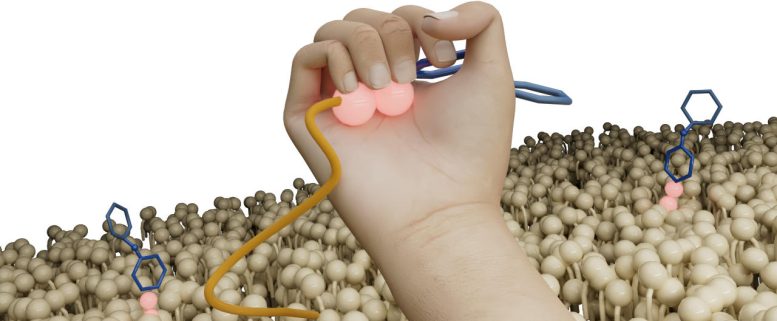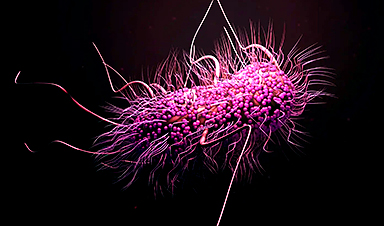A novel antibiotic named Clovibactin, extracted from previously uncultivable bacteria, has been found effective against harmful bacteria, including multi-resistant “superbugs”. Clovibactin’s unique mechanism of targeting multiple essential precursor molecules in the bacterial cell wall makes it difficult for bacteria to become resistant to it.
Researchers from Utrecht University, Bonn University (Germany), the German Center for Infection Research (DZIF), Northeastern University of Boston (USA), and the company NovoBiotic Pharmaceuticals (Cambridge, USA) now share the discovery of Clovibactin and its killing mechanism in the scientific journal Cell.
There is an urgent need for new antibiotics
Antimicrobial resistance is a major problem for human health and researchers worldwide are looking for new solutions. “We urgently need new antibiotics to combat bacteria that become increasingly resistant to most clinically used antibiotics,” says Dr. Markus Weingarth, a researcher from the Chemistry Department of Utrecht University.
“Clovibactin is different,” says Weingarth. “Since Clovibactin was isolated from bacteria that could not be grown before, pathogenic bacteria have not seen such an antibiotic before and had no time to develop resistance.”

The newly discovered antibiotic Clovibactin uses an unsual cage-like binding motif to tightly wrap around special lipids in bacterial cell membranes. Credit: Markus Weingarth
Antibiotic from bacterial dark matter
Clovibactin was discovered by NovoBiotic Pharmaceuticals, a small US-based early-stage company, and microbiologist Prof. Kim Lewis from Northeastern University, Boston. Earlier, they developed a device that allows the growth of ‘bacterial dark matter’, which are so-called unculturable bacteria. Intriguingly, 99% of all bacteria are ‘unculturable’ and could not be grown in laboratories previously, hence they could not be mined for novel antibiotics. Using the device, called iCHip, the US researchers discovered Clovibactin in a bacterium isolated from sandy soil from North Carolina: E. terrae ssp. Carolina.
In the joint Cell publication, NovoBiotic Pharmaceuticals shows that Clovibactin successfully attacks a broad spectrum of bacterial pathogens. It was also successfully used to treat mice infected with the superbug Staphylococcus aureus.
A broad target spectrum
Clovibactin appears to have an unusual killing mechanism. It targets not just one, but three different precursor molecules that are all essential for the construction of the cell wall, an envelope-like structure that surrounds bacteria. This was discovered by the group of Prof. Tanja Schneider from the University of Bonn in Germany, one of the Cell paper’s co-authors.
Schneider: “The multi-target attack mechanism of Clovibactin blocks bacterial cell wall synthesis simultaneously at different positions. This improves the drug’s activity and substantially increases its robustness to resistance development.”
A cage-like structure
How exactly Clovibactin blocks the synthesis of the bacterial cell wall was unraveled by the team of Dr. Markus Weingarth from Utrecht University. They used a special technique called solid-state nuclear magnetic resonance (NMR) that allowed them to study Clovibactin’s mechanism under similar conditions as in bacteria.
“Clovibactin wraps around the pyrophosphate like a tightly fitting glove. Like a cage that encloses its target” says Weingarth. This is what gives Clovibactin its name, which is derived from the Greek word “Klouvi”, which means cage. The remarkable aspect of Clovibactin’s mechanism is that it only binds to the immutable pyrophosphate that is common to cell wall precursors, but it ignores that variable sugar-peptide part of the targets. “As Clovibactin only binds to the immutable, conserved part of its targets, bacteria will have a much harder time developing any resistance against it. In fact, we did not observe any resistance to Clovibactin in our studies.”
Fibrils capture the targets
Clovibactin can do even more. Upon binding the target molecules, it self-assembles into large fibrils on the surface of bacterial membranes. These fibrils are stable for a long time and thereby ensure that the target molecules remain sequestered for as long as necessary to kill bacteria.
“Since these fibrils only form on bacterial membranes and not on human membranes, they are presumably also the reason why Clovibactin selectively damages bacterial cells but is not toxic to human cells,” says Weingarth. “Clovibactin hence has potential for the design of improved therapeutics that kill bacterial pathogens without resistance development.”
Reference: “An antibiotic from an uncultured bacterium binds to an immutable target” by Rhythm Shukla, Aaron J. Peoples, Kevin C. Ludwig, Sourav Maity, Maik G.N. Derks, Stefania De Benedetti, Annika M. Krueger, Bram J.A. Vermeulen, Theresa Harbig, Francesca Lavore, Raj Kumar, Rodrigo V. Honorato, Fabian Grein, Kay Nieselt, Yangping Liu, Alexandre M.J.J. Bonvin, Marc Baldus, Ulrich Kubitscheck, Eefjan Breukink, Catherine Achorn and Markus Weingarth, 22 August 2023, Cell.
DOI: 10.1016/j.cell.2023.07.038
News
Scientists Melt Cancer’s Hidden “Power Hubs” and Stop Tumor Growth
Researchers discovered that in a rare kidney cancer, RNA builds droplet-like hubs that act as growth control centers inside tumor cells. By engineering a molecular switch to dissolve these hubs, they were able to halt cancer [...]
Platelet-inspired nanoparticles could improve treatment of inflammatory diseases
Scientists have developed platelet-inspired nanoparticles that deliver anti-inflammatory drugs directly to brain-computer interface implants, doubling their effectiveness. Scientists have found a way to improve the performance of brain-computer interface (BCI) electrodes by delivering anti-inflammatory drugs directly [...]
After 150 years, a new chapter in cancer therapy is finally beginning
For decades, researchers have been looking for ways to destroy cancer cells in a targeted manner without further weakening the body. But for many patients whose immune system is severely impaired by chemotherapy or radiation, [...]
Older chemical libraries show promise for fighting resistant strains of COVID-19 virus
SARS‑CoV‑2, the virus that causes COVID-19, continues to mutate, with some newer strains becoming less responsive to current antiviral treatments like Paxlovid. Now, University of California San Diego scientists and an international team of [...]
Lower doses of immunotherapy for skin cancer give better results, study suggests
According to a new study, lower doses of approved immunotherapy for malignant melanoma can give better results against tumors, while reducing side effects. This is reported by researchers at Karolinska Institutet in the Journal of the National [...]
Researchers highlight five pathways through which microplastics can harm the brain
Microplastics could be fueling neurodegenerative diseases like Alzheimer's and Parkinson's, with a new study highlighting five ways microplastics can trigger inflammation and damage in the brain. More than 57 million people live with dementia, [...]
Tiny Metal Nanodots Obliterate Cancer Cells While Largely Sparing Healthy Tissue
Scientists have developed tiny metal-oxide particles that push cancer cells past their stress limits while sparing healthy tissue. An international team led by RMIT University has developed tiny particles called nanodots, crafted from a metallic compound, [...]
Gold Nanoclusters Could Supercharge Quantum Computers
Researchers found that gold “super atoms” can behave like the atoms in top-tier quantum systems—only far easier to scale. These tiny clusters can be customized at the molecular level, offering a powerful, tunable foundation [...]
A single shot of HPV vaccine may be enough to fight cervical cancer, study finds
WASHINGTON -- A single HPV vaccination appears just as effective as two doses at preventing the viral infection that causes cervical cancer, researchers reported Wednesday. HPV, or human papillomavirus, is very common and spread [...]
New technique overcomes technological barrier in 3D brain imaging
Scientists at the Swiss Light Source SLS have succeeded in mapping a piece of brain tissue in 3D at unprecedented resolution using X-rays, non-destructively. The breakthrough overcomes a long-standing technological barrier that had limited [...]
Scientists Uncover Hidden Blood Pattern in Long COVID
Researchers found persistent microclot and NET structures in Long COVID blood that may explain long-lasting symptoms. Researchers examining Long COVID have identified a structural connection between circulating microclots and neutrophil extracellular traps (NETs). The [...]
This Cellular Trick Helps Cancer Spread, but Could Also Stop It
Groups of normal cbiells can sense far into their surroundings, helping explain cancer cell migration. Understanding this ability could lead to new ways to limit tumor spread. The tale of the princess and the [...]
New mRNA therapy targets drug-resistant pneumonia
Bacteria that multiply on surfaces are a major headache in health care when they gain a foothold on, for example, implants or in catheters. Researchers at Chalmers University of Technology in Sweden have found [...]
Current Heart Health Guidelines Are Failing To Catch a Deadly Genetic Killer
New research reveals that standard screening misses most people with a common inherited cholesterol disorder. A Mayo Clinic study reports that current genetic screening guidelines overlook most people who have familial hypercholesterolemia, an inherited disorder that [...]
Scientists Identify the Evolutionary “Purpose” of Consciousness
Summary: Researchers at Ruhr University Bochum explore why consciousness evolved and why different species developed it in distinct ways. By comparing humans with birds, they show that complex awareness may arise through different neural architectures yet [...]
Novel mRNA therapy curbs antibiotic-resistant infections in preclinical lung models
Researchers at the Icahn School of Medicine at Mount Sinai and collaborators have reported early success with a novel mRNA-based therapy designed to combat antibiotic-resistant bacteria. The findings, published in Nature Biotechnology, show that in [...]





















